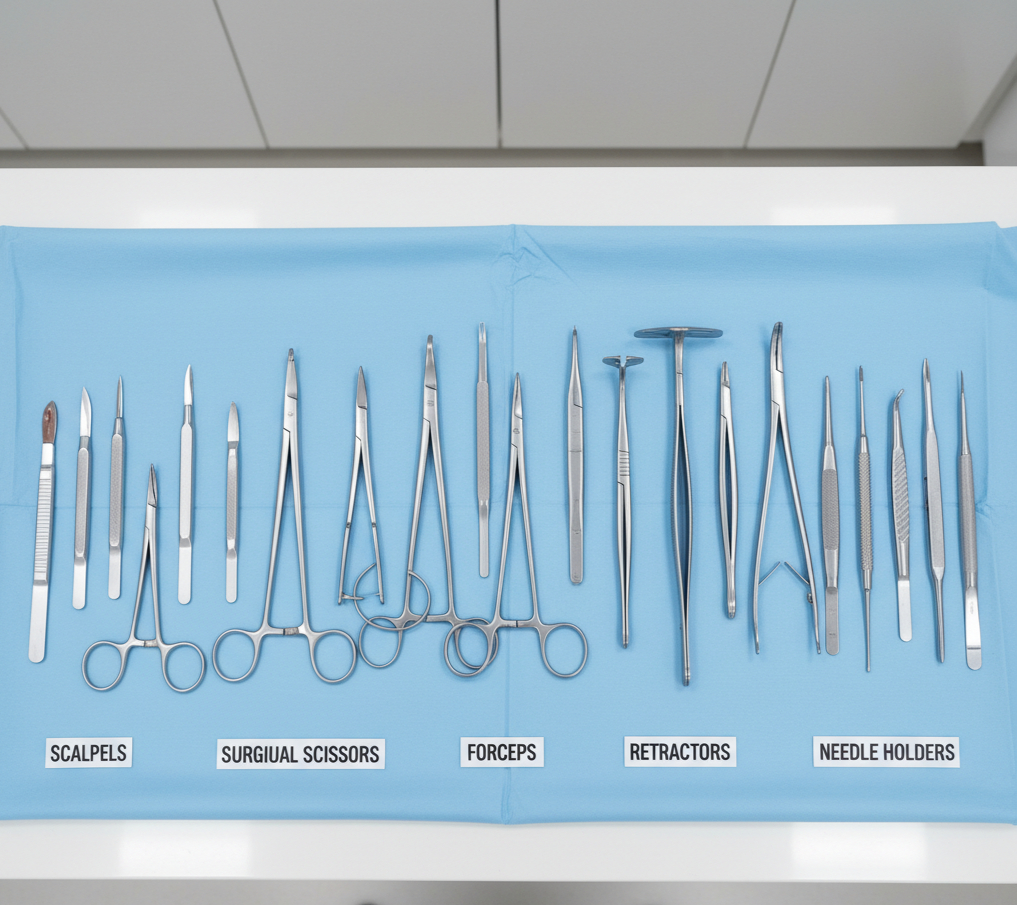Introduction
Surgery is impossible without the right tools, and knowing the pictures and names of surgical instruments is essential for medical students, nurses, and surgical professionals. From scalpels and scissors to retractors and clamps, each instrument has a specific role in ensuring surgical precision.
In this guide, we will explore the most important surgical instruments, their names, functions, and categories, with descriptions that complement their typical pictures.
Why Learn the Pictures and Names of Surgical Instruments?
- Medical Education: Students and trainees must recognize tools quickly.
- Surgical Safety: Correct identification prevents mistakes during procedures.
- Instrument Handling: Knowing the right name helps in passing instruments efficiently.
- Global Standardization: Surgical teams worldwide use similar terms for better communication.
- Historical and Practical Value: Understanding instruments shows how surgery has evolved.
Main Categories of Surgical Instruments
H2: Cutting and Dissecting Instruments
H3: Scalpel
A scalpel is a sharp knife used for precise incisions. It comes in disposable and reusable types.
H3: Surgical Scissors
Different scissors, such as Mayo and Metzenbaum scissors, are used to cut tissues or sutures.
H2: Grasping and Holding Instruments
H3: Forceps
- Tissue forceps – grip tissues during surgery.
- Dressing forceps – hold dressings or materials.
H3: Needle Holders
Used for holding needles during suturing, ensuring accuracy and stability.
H2: Clamping and Occluding Instruments
H3: Hemostats
Hemostats clamp blood vessels to stop bleeding. Common types include Kelly and Mosquito clamps.
H3: Artery Forceps
Specialized for clamping arteries during surgery.
H2: Retracting and Exposing Instruments
H3: Retractors
Retractors like the Senn, Army-Navy, and Balfour hold tissues apart for better visibility.
H3: Speculum
A speculum is used to open cavities, especially in gynecology.
H2: Suturing and Stapling Instruments
H3: Needle Drivers
Used for holding suturing needles.
H3: Surgical Staplers
Modern instruments that close wounds quickly and effectively.
H2: Suctioning, Probing, and Dilating Instruments
H3: Suction Tubes
Yankauer suction tips and Poole suction tubes remove fluids from the surgical site.
H3: Probes and Dilators
Used for exploring wounds or dilating openings in body structures.
Pictures and Names of Specialized Surgical Instruments
H2: Orthopedic Instruments
H3: Bone Saw
Used for cutting bones in orthopedic surgeries.
H3: Osteotome
Chisel-like tool for bone work.
H2: Gynecological Instruments
H3: Tenaculum
A sharp hook used to hold tissues in gynecology.
H3: Dilators
Hegar dilators are used to enlarge the cervical opening.
H2: Dental Instruments
H3: Extracting Forceps
Used to remove teeth with controlled force.
H3: Elevators
Loosen teeth before extraction.
H2: Ophthalmic Instruments
H3: Fine Forceps
Delicate forceps used in eye surgeries.
H3: Iris Scissors
Small scissors designed for cutting eye tissue.
Identifying Surgical Instruments with Pictures
Medical students often use guides with pictures and names of surgical instruments to aid quick learning. Instruments are usually photographed:
- On sterile trays.
- Arranged by category.
- With close-up views to show design.
- Sometimes labeled with their names for clarity.
Such resources are essential for exams, practical training, and clinical practice.
How Many Surgical Instruments Exist?
There are hundreds of surgical instruments, but they are usually grouped into the categories listed above. Standard surgical sets may include:
- General Surgery Set: 100–150 instruments.
- Specialized Sets: Orthopedic, neurosurgical, or gynecological instruments.
- Dental Kits: 20–50 instruments depending on procedure.
Comparing Pictures and Names of Old vs. Modern Instruments
| Feature | Old Instruments | Modern Instruments |
|---|---|---|
| Material | Bronze, iron, ivory | Stainless steel, titanium |
| Sterilization | Rarely sterilized | Autoclaved, chemically disinfected |
| Design | Simple, multi-use | Specialized, ergonomic |
| Examples | Trephines, crude scalpels | Robotic scalpels, powered drills |
Best Resources to Learn Pictures and Names of Surgical Instruments
- Medical Textbooks: Standard reference guides include detailed illustrations.
- Surgical Instrument Catalogs: Suppliers provide labeled pictures.
- Online Courses and PDFs: Digital resources with categorized images.
- Medical Museums: Display antique and modern instruments.
- Training Workshops: Hands-on learning with real tools.
FAQs About Pictures and Names of Surgical Instruments
1. Why is it important to learn the pictures and names of surgical instruments?
It ensures safety, efficiency, and effective communication in the operating room.
2. How many surgical instruments exist?
There are hundreds, categorized into cutting, grasping, clamping, retracting, suturing, and suctioning instruments.
3. What is the best way to learn surgical instruments?
Using labeled pictures, flashcards, and practice in surgical labs.
4. Are pictures of surgical instruments available online?
Yes, many medical suppliers and training websites provide free catalogs with names and images.
5. Do surgical instruments look the same worldwide?
Most instruments are standardized, but variations exist depending on manufacturer and region.
Conclusio
The study of pictures and names of surgical instruments is essential for every medical professional. From scalpels and scissors to retractors and clamps, these tools are the foundation of safe surgical practice. Recognizing instruments by both appearance and name enhances efficiency, ensures precision, and reduces risks during procedures.
Whether you are a student preparing for exams or a professional updating your knowledge, exploring surgical instruments with pictures is a vital step in mastering surgical science.

